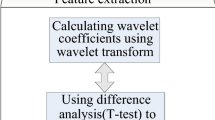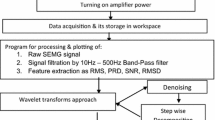Abstract
Physical actions classification of surface electromyography (sEMG) signal is required in applications like prosthesis, and robotic control etc. In this paper, tunable-Q factor wavelet transform (TQWT) based algorithm is proposed for the classification of physical actions such as clapping, hugging, bowing, handshaking, standing, running, jumping, waving, seating, and walking. sEMG signal is decomposed into sub-bands by TQWT. Various features are extracted from each different band and statistical analysis is performed. These features are fed into multi-class least squares support vector machine classifier using two non-linear kernel functions, morlet wavelet function, and radial basis function. The proposed method is an attempt for classifying physical actions using TQWT and its performance and results are promising and have high classification accuracy of 97.74% for sub-band eight with morlet kernel function.



Similar content being viewed by others
References
Pan J, Yang B, Cai S, Wang Z, Gao F, Bao G, Yang Q. Finger motion pattern recognition based on sEMG support vector machine. In: 2017 IEEE international conference on cyborg and bionic systems (CBS), IEEE, pp. 282–8; 2017.
Sahinbegovic H, Music L, Alic B. Distinguishing physical actions using an artificial neural network. In: 2017 XXVI international conference on information, communication and automation technologies (ICAT), IEEE, pp. 1–5; 2017.
Fattah SA, Iqbal O, Zahin S, Shahnaz C, Rosul G. Basic hand action classification based on surface EMG using autoregressive reflection coefficient. In: Region 10 conference, TENCON 2017, IEEE, pp. 1369–74; 2017.
Nagineni S, Taran S, Bajaj V. Features based on variational mode decomposition for identification of neuromuscular disorder using EMG signals. Health Inf Sci Syst. 2018;6(1):13.
Nagineni S, Taran S, Bajaj V. Physical actions classification of surface EMG signals using vmd. In: International conference on communication and signal processing, IEEE, pp. 1–5; 2018.
Caesarendra W, Tjahjowidodo T, Nico Y, Wahyudati S, Nurhasanah L. EMG finger movement classification based on anfis. In: Journal of Physics: conference series, vol 1007, IOP Publishing, p. 012005; 2018.
Mayor J, Rodacki A, Bastos T. Classification of dexterous hand movements based on myoelectric signals using neural networks. Anais COBEC-SEB 302–305. 2007. https://doi.org/10.29327/cobecseb.78982
Sapienza S, Ros PM, Guzman DAF, Rossi F, Terracciano R, Cordedda E, Demarchi D. On-line event-driven hand gesture recognition based on surface electromyographic signals. In: 2018 IEEE international symposium on circuits and systems (IS-CAS), IEEE, pp. 1–5; 2018.
Zhang X-F, Li X, Dai J-T, Pan G-X, Zhang N, Fu H-Q, Xu J-G, Zhong Z-C, Liu T, Inoue Y. The design of a hemiplegic upper limb rehabilitation training system based on surface EMG signals. J Adv Mech Des Syst Manuf. 2018;12:1.
Shi W-T, Lyu Z-J, Tang S-T, Chia T-L, Yang C-Y. A bionic hand controlled by hand gesture recognition based on surface EMG signals: a preliminary study. Biocybern Biomed Eng. 2018;38(1):126–35.
Baspinar U, Varol HS, Senyurek VY. Performance comparison of artificial neural network and gaussian mixture model in classifying hand motions by using sEMG signals. Biocybern Biomed Eng. 2013;33(1):33–45.
Ortes F, Karabulut D, Arslan YZ. General perspectives on electromyography signal features and classifiers used for control of human arm prosthetics. In: Encyclopedia of Information Science and Technology, 4th Edition, IGI Global, pp. 492–504; 2018.
Jarrasse N, Nicol C, Touillet A, Richer F, Martinet N, Paysant J, de Graaf JB. Classification of phantom finger, hand, wrist, and elbow voluntary gestures in transhumeral amputees with sEMG. IEEE Trans. Neural Syst. Rehabil. Eng. 2017;25(1):71–80.
Gandolla M, Ferrante S, Ferrigno G, Baldassini D, Molteni F, Guanziroli E, Cotti Cottini M, Seneci C, Pedrocchi A. Artificial neural network EMG classifier for functional hand grasp movements prediction. J. Int. Med. Res. 2017;45(6):1831–47.
Sravani C, Bajaj V, Taran S, Sengur A. Flexible analytic wavelet transform based features for physical action identification using sEMG signals. IRBM, in press; 2019.
Mishra VK, Varun B, Kumar A, Sharma D, Singh GK. An efficient method for analysis of EMG signals using improved empirical mode decomposition. AEU Int J Electron Commun. 2017;72:200–9.
Jana GC, Swetapadma A, Pattnaik P. An intelligent method for classification of normal and aggressive actions from electromyography signals. In: 2017 1st international conference on electronics, materials engineering and nano-technology (IEMENTech), IEEE, pp. 1–5; 2017.
Chen Y, Yang Z, Gong H, Wang S. Recognition of sketching from surface electromyography. Neural Comput Appl. 2017;30:2725–37.
Ryu J, Lee B-H, Kim D-H. sEMG signal-based lower limb human motion detection using a top and slope feature extraction algorithm. IEEE Signal Process Lett. 2017;24(7):929–32.
Zhang H, Yang D, Shi C, Jiang L, Liu H. Robust EMG pattern recognition with electrode donning/doffing and multiple confounding factors. In: International conference on intelligent robotics and applications, Springer, New York, pp. 413–24; 2017.
Jiralerspong T, Nakanishi E, Liu C, Ishikawa J. Experimental study of real-time classification of 17 voluntary movements for multi-degree myoelectric prosthetic hand. Appl Sci. 2017;7(11):1163.
Akben SB. Low-cost and easy-to-use grasp classification, using a simple 2-channel surface electromyography (sEMG). Biomed Res. 2017;28(2):577–82.
Ai Q, Zhang Y, Qi W, Liu Q, et al. Research on lower limb motion recognition based on fusion of sEMG and accelerometer signals. Symmetry. 2017;9(8):147.
Naik GR, Al-Timemy AH, Nguyen HT. Transradial amputee gesture classification using an optimal number of sEMG sensors: an approach using ica clustering. IEEE Trans Neural Syst Rehabil Eng. 2016;24(8):837–46.
Li Y, Gao F, Chen H, Xu M. Gait recognition based on EMG with different 285 individuals and sample sizes. In: 35th Chinese control conference (CCC), IEEE, pp. 4068–72; 2016.
Li H-T, Han S-L, Pan M-C. Lower-limb motion classification for hemiparetic patients through imu and EMG signal processing. In: International conference on biomedical engineering (BME-HUST), IEEE, pp. 113–8; 2016.
Adewuyi AA, Hargrove LJ, Kuiken TA. An analysis of intrinsic and extrinsic hand muscle EMG for improved pattern recognition control. IEEE Trans Neural Syst Rehabil Eng. 2016;24(4):485–94.
Wang K, Zhang X, Ota J, Huang Y. Estimation of handgrip force from sEMG based on wavelet scale selection. Sensors. 2018;18(2):663.
Vigotsky AD, Halperin I, Lehman GJ, Trajano GS, Vieira TM. Interpreting signal amplitudes in surface electromyography studies in sport and rehabilitation sciences. Front Physiol. 2018;8:985.
Tiboni M, Borboni A, Faglia R, Pellegrini N. Robotics rehabilitation of the elbow based on surface electromyography signals. Adv Mech Eng. 2018;10(2):1687814018754590.
Wang L, Wang Y, Ma A, Ma G, Ye Y, Li R, Lu T. A comparative study of EMG indices in muscle fatigue evaluation based on grey relational analysis during all-out cycling exercise. BioMed Res Int; 2018.
Garca JMY, Rosell DR, Custodio RM, Garca AGR, Ribas J. Reliability of mechanical and EMG variables assessed during concentric bench press exercise against different submaximal loads. Biomed J Sci Technol Res; 2018.
Krasoulis A, Kyranou I, Erden MS, Nazarpour K, Vijayakumar S. Improved prosthetic hand control with concurrent use of myoelectric and inertial measurements. J Neuroeng Rehabil. 2017;14(1):71.
Cuesta-Vargas AI, Cano-Herrera CL. Surface electromyography during physical exercise in water: a systematic review. BMC Sports Sci Med Rehabil. 2014;6(1):15.
Reddy GRS, Rao R. Automated identification system for seizure EEG signals using tunable-q wavelet transform. Eng Sci Technol Int J. 2017;20(5):1486–93.
Al Ghayab HR, Li Y, Siuly S, Abdulla S. A feature extraction technique based on tunable q-factor wavelet transform for brain signal classification. J Neurosci Methods. 2019;312:43–52.
Hassan AR, Siuly S, Zhang Y. Epileptic seizure detection in eeg signals using tunable-q factor wavelet transform and bootstrap aggregating. Comput Methods Programs Biomed. 2016;137:247–59.
Krishna AH, Sri AB, Priyanka KYVS, Taran S, Bajaj V. Emotion classification using EEG signals based on tunable-Q wavelet transform. IET Sci Meas Technol. 2019;13(3):375–80.
Kumar TS, Kanhangad V. Face recognition using two-dimensional tunable-q wavelet transform. In: 2015 international conference on digital image computing: techniques and applications (DICTA), IEEE, pp. 1–7; 2015.
Thirumala K, Maganuru SP, Jain T, Umarikar A. Tunable-q wavelet transform and dual multiclass svm for online automatic detection of power quality disturbances. IEEE Trans Smart Grid. 2018;9(4):3018–28.
Doshi S, Shrimali M, Rajendra SK, Sharma M. Tunable q-factor wavelet transform for classifying mechanical deformations in power transformer. In: 2018 5th international conference on signal processing and integrated networks (SPIN), IEEE, pp. 661–6; 2018.
Zheng BS, Khairunizam W, Murugappan Murugappan SA, Razlan ZM, Zunaidi I, Yean CW. Effectiveness of tuned q-factor wavelet transform in emotion recognition among left-brain damaged stroke patients. Int J Simul Syst Sci Technol. 2018;19(3):2.
Taran S, Bajaj V. Motor imagery tasks-based eeg signals classification using tunable-q wavelet transform. Neural Comput Appl. 2018;31:6925–32.
Upadhyay N, Kankar PK. Diagnosis of bearing defects using tunable q-wavelet transform. J Mech Sci Technol. 2018;32(2):549–58.
Dheeru D, Karra Taniskidou E. UCI machine learning repository. 2017. http://archive.ics.uci.edu/ml
Hassan AR, Bhuiyan MIH. A decision support system for automatic sleep staging from eeg signals using tunable q-factor wavelet transform and spectral features. J Neurosci Methods. 2016;271:107–18.
Taran S, Bajaj V, Siuly S. An optimum allocation sampling based feature extraction scheme for distinguishing seizure and seizure-free eeg signals. Health Inf Sci Syst. 2017;5(1):7–17.
Phinyomark A, Phukpattaranont P, Limsakul C. Feature reduction and selection for EMG signal classification. Expert Syst Appl. 2012;39(8):7420–31.
Suykens JA, Vandewalle J. Multiclass least squares support vector machines. In: Proceedings of the international joint conference on neural networks, pp. 900–3; 1999.
Bajaj V, Pachori RB. Classification of seizure and nonseizure eeg signals using empirical mode decomposition. IEEE Trans Inf Technol Biomed. 2012;16(6):1135–42.
Abdullah AA, Subasi A, Qaisar SM. Surface EMG signal classification by using wpd and ensemble tree classifiers. In: Badnjevic A, editor. CMBEBIH 2017. Singapore: Springer; 2017. p. 475–81.
Author information
Authors and Affiliations
Corresponding author
Additional information
Publisher's Note
Springer Nature remains neutral with regard to jurisdictional claims in published maps and institutional affiliations.
Rights and permissions
About this article
Cite this article
Chada, S., Taran, S. & Bajaj, V. An efficient approach for physical actions classification using surface EMG signals. Health Inf Sci Syst 8, 3 (2020). https://doi.org/10.1007/s13755-019-0092-2
Received:
Accepted:
Published:
DOI: https://doi.org/10.1007/s13755-019-0092-2




